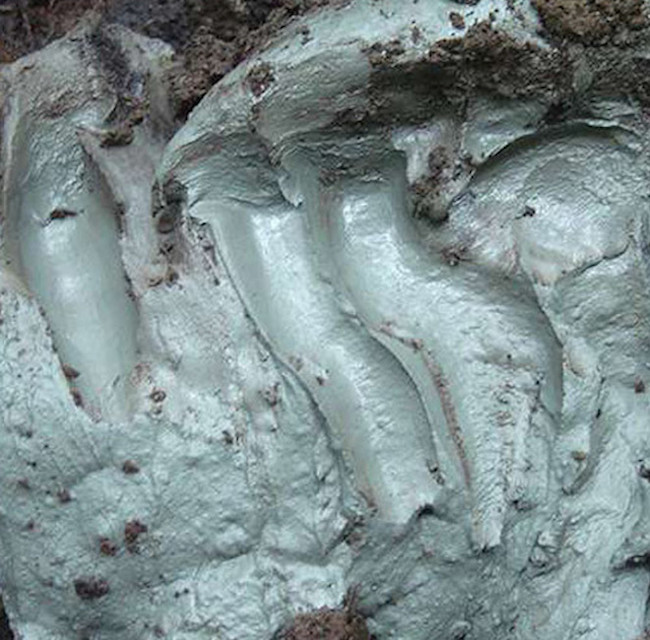Researchers at the University of B.C. have confirmed a discovery credited to the Heiltsuk First Nation, a tribe of people who live 400 kilometers north of Vancouver. The Heiltsuk live next to a 400-million kilogram deposit of glacial clay that formed about 10,000 years ago, near the end of the last Ice Age.
Above image: Raw glacial clay from Kisameet Bay. Courtesy of Kisameet Glacial Clay Inc.
From the National Post:
The grey-green clay, known as Kisolite, has been used for centuries by the Heiltsuk First Nations to treat a range of ailments, including ulcerative colitis, arthritis, neuritis, phlebitis, skin irritation, and burns. Locals have also historically used the clay for eczema, acne and psoriasis.
But the clay may have another application: killing all those tricky bacteria that have resistances to antibiotics. In the arms race against continually mutating diseases, the newest weapon is a folk remedy. Weird.
Testing conducted by UBC microbiologist Julian Davies and researcher Shekooh Behroozian found that the clay, suspended in water, killed 16 strains of ESKAPE bacteria samples from sources including Vancouver General Hospital, St. Paul’s Hospital, and the University of B.C.’s waste water treatment plant.
As a result of those tests, the scientists recommend the clay be studied as a clinical treatment for serious infections caused by ESKAPE strains of bacteria, a group of potentially deadly pathogens that cause many infections to “escape” antibiotics.
“Infections caused by ESKAPE bacteria are essentially untreatable and contribute to increasing mortality in hospitals,” said Davies, the co-author of a paper published Tuesday in the American Society for Microbiology’s mBio journal.

Researchers Julian Davies and Shekooh Behroozian inspect a bucket of clay. Courtesy of National Post and University of British Columbia.
The researchers were approached by Kisameet Glacial Clay, a company that markets cosmetic and medicinal products made from the clay. Davies said he was skeptical at first, but was surprised to learn that the clay killed all 16 strains of bacteria it encountered.
They’re doing more tests before moving on to clinical studies. The work is partially funded by the company, and so I’m still a little skeptical that it’s really the miracle cure the researchers claim. The narrative behind it is so cliché it almost has to have been dreamed up by someone who works in marketing: a lowly substance known only to the ancients has amazing healing properties that leave modern scientists baffled. Heard it before. Apparently the clay was researched by MIT scientists in the 1950s who confirmed that it had healing properties. So why the 66-year gap? What happened? The information in the few articles we read is rather scant.
The “rare” qualifier concerns me, too. How rare? Can a cure be derived from the clay while not using up the limited supply? That would be awfully unfair to the Heiltsuk, who essentially handed this discovery to the researchers. Hopefully they’re getting something back on the deal.
But the most pressing question of all: is there a way to charge people stateside $1,000 a pill for this cure? More research is needed indeed.
Bill Rodgers is the Managing Editor of cfile.daily.
Love (not quite) contemporary ceramics? Let us know in the comments. Also, if you have any professional background that could put this story in context, please let us know.

Add your valued opinion to this post.